It can be difficult to distinguish between various vendors that market, advertise and purport to solve the same store operational and workforce management challenges. This page is for those looking to peel back the layers and separate marketing hype from pragmatic conversation. This is your deeper dive into some of the key differentiators that separate Logile from our competition.
Executing your brand strategy
Your brand is what makes your business unique and defines your value proposition. It starts with your facility, product assortment, marketing identity and service strategies. It gets further defined as you translate those definitions into the way you staff, plan and merchandise your stores.
The goal here is to put the right people in the right place at the right time doing the right things in the right way—as defined in your best methods and labor standards. Our ecosystem of labor solutions enables you to manage each component of the process and deliver your brand consistently across big enterprises and wide geographies.
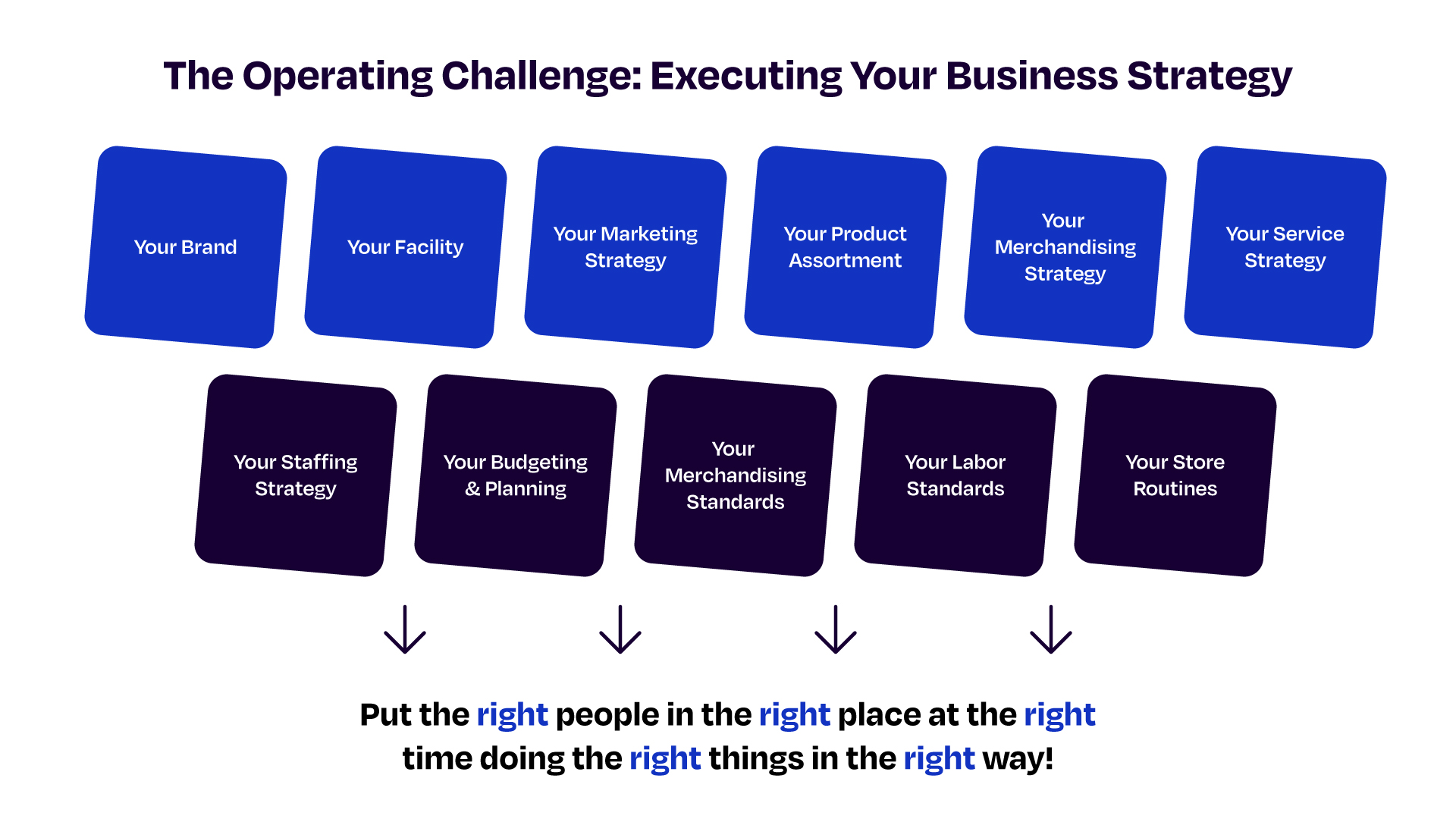
The labor model
The Enterprise Labor Model is the core of the Logile Advantage. It enables a complete understanding of work content, by task and operation, including fixed work and variable components associated with a forecast labor driver. From your library of labor standards, store profiles determine which standards are appropriate for each store. These standards are further refined by store characteristics to custom fit each standard to the facility and equipment in each specific store.
While our system fully supports organizations that wish to manage labor using older sales per hour (SPH) or wage percent (payroll dollars/sales) approaches, the earned hours approach provides the best way to plan and execute your labor to put the right people at the right place at the right time.
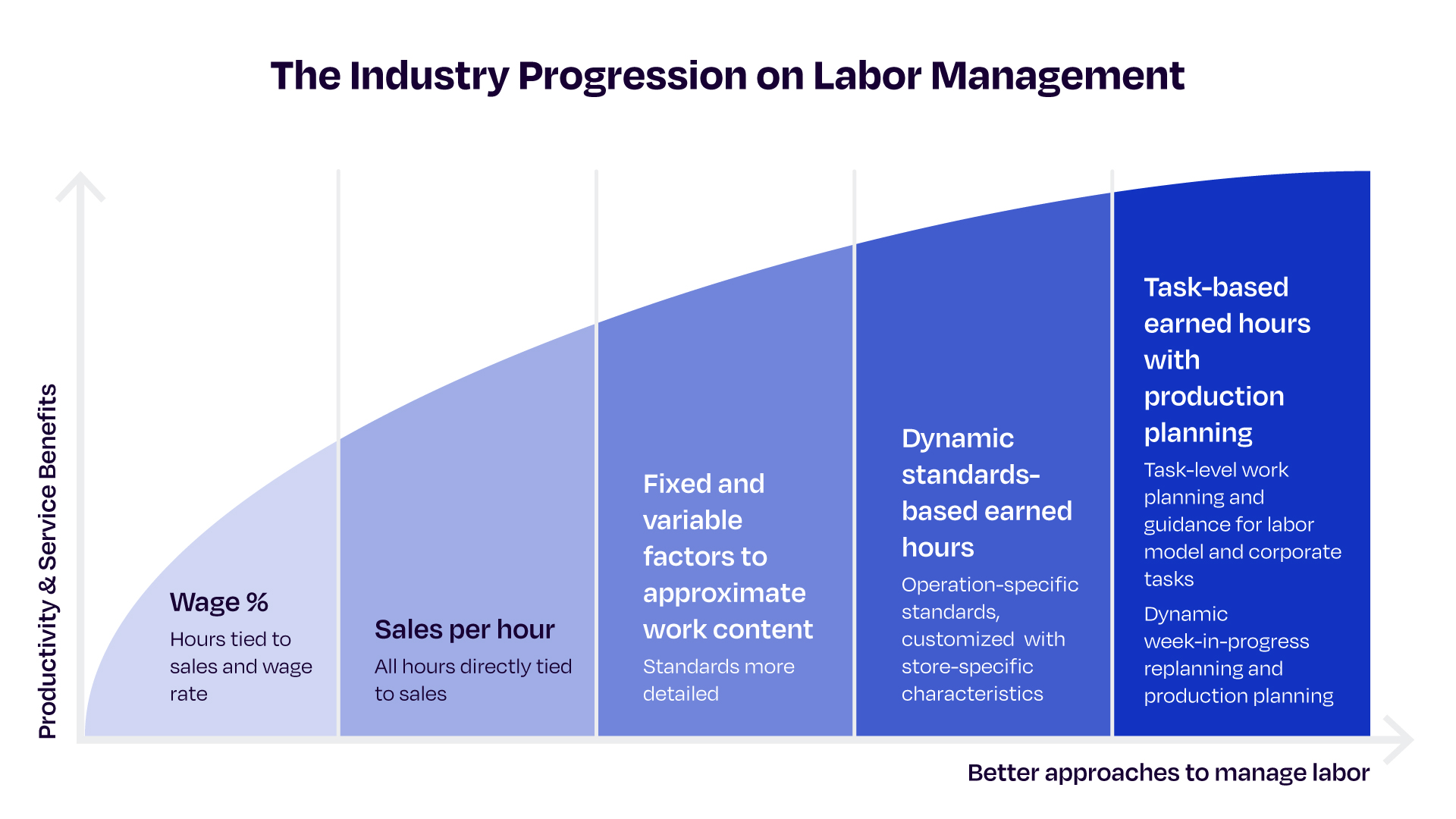
With a wage percent approach, hours increase as sales increase. The amount of hours is relative to the rate of pay, not to the amount of work required.
With an SPH approach, hours increase or decline in direct correlation with sales. But in low sales weeks, fixed work is also cut. And in high sales weeks, these activities get more time than they really need; and the organization fails to leverage incremental sales.
In an earned hours approach, fixed tasks remain constant while variable work content increases or decreases with sales, as it should. Service is not compromised week to week as a result of a one-dimensional approach, and fixed tasks like cleaning are not neglected in low-volume weeks. This means departments do not have to run in perpetual “catch up” mode.
Use of the labor model in this way is most typically described as a work content-based or earned hours-based program.
Operating an earned hours program
Operating an earned hours program requires keeping your labor model in sync with your business and financial objectives. Your forecast drives the amount of variable work for any given week. Fixed work is added to the variable work to define the total amount of hours earned by work content.
Actual earned hours performance is calculated based on the actual items, customers, cases, etc. that were handled and applying those values to standards and staffing parameters. The goal for each store is to use as close to 100 percent of the hours they earn for the actual workload experienced. When stores achieve exactly the right number of hours, they have an earned ratio or operating ratio of 100 percent. When stores use more hours, their performance will fall below 100 percent.
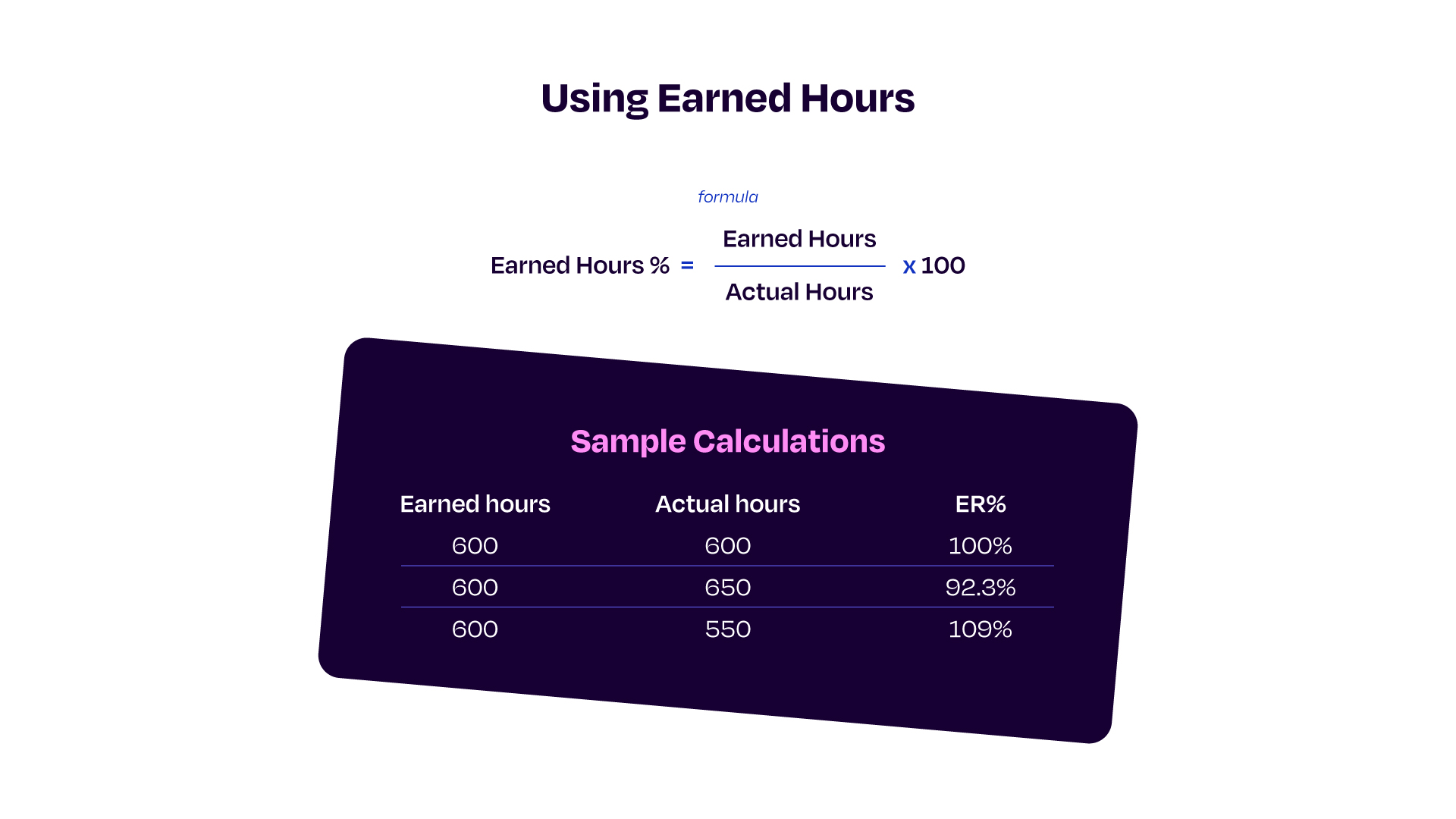
With earned hours, the goal is not to beat the standards and offer accolades to stores achieving 110 percent earned ratio performance. These stores should be cautioned about compromising merchandising programs, store conditions or service standards by using less hours than company standards require. Meanwhile, stores achieving less than 100 percent should be coached to better use the hours they earn to accomplish all work without the use of excess hours.
Other metrics such as wage percent, SPH, total time per item, total time per customer, etc. can be useful to a labor expert as industry benchmarks or as fresh perspectives to develop optimization priorities. However, the labor model must be aligned to support the true work content defined at the 100 percent earned ratio level and allow SPH and wage percent values to vary from week to week based on work content.
Building your planning and execution management ecosystem
One challenge many organizations face is the book value of sunk investments. Often an organization cannot replace its entire system even if it recognizes the limitations of that system. Logile provides expert integration services to overcome this challenge, allowing our customers to target investments to the weakest links in their ecosystems and then grow their footprint from the benefits realized.
In many cases, the labor model and our Enterprise Standards Manager (ESM) and Enterprise Labor Model (ELM) solutions are the best place to start. Another typical area of first focus is Forecasting. Others have started with Logile’s Task Engine and customized apps to improve execution management.
Whatever your needs and sunk investments are, Logile can work with you and integrate systems effectively, enabling you to fund a state-of-the-art planning and execution management ecosystem at your pace. Start with fixing your most pressing needs and reinvest your ROI in additional components over time.
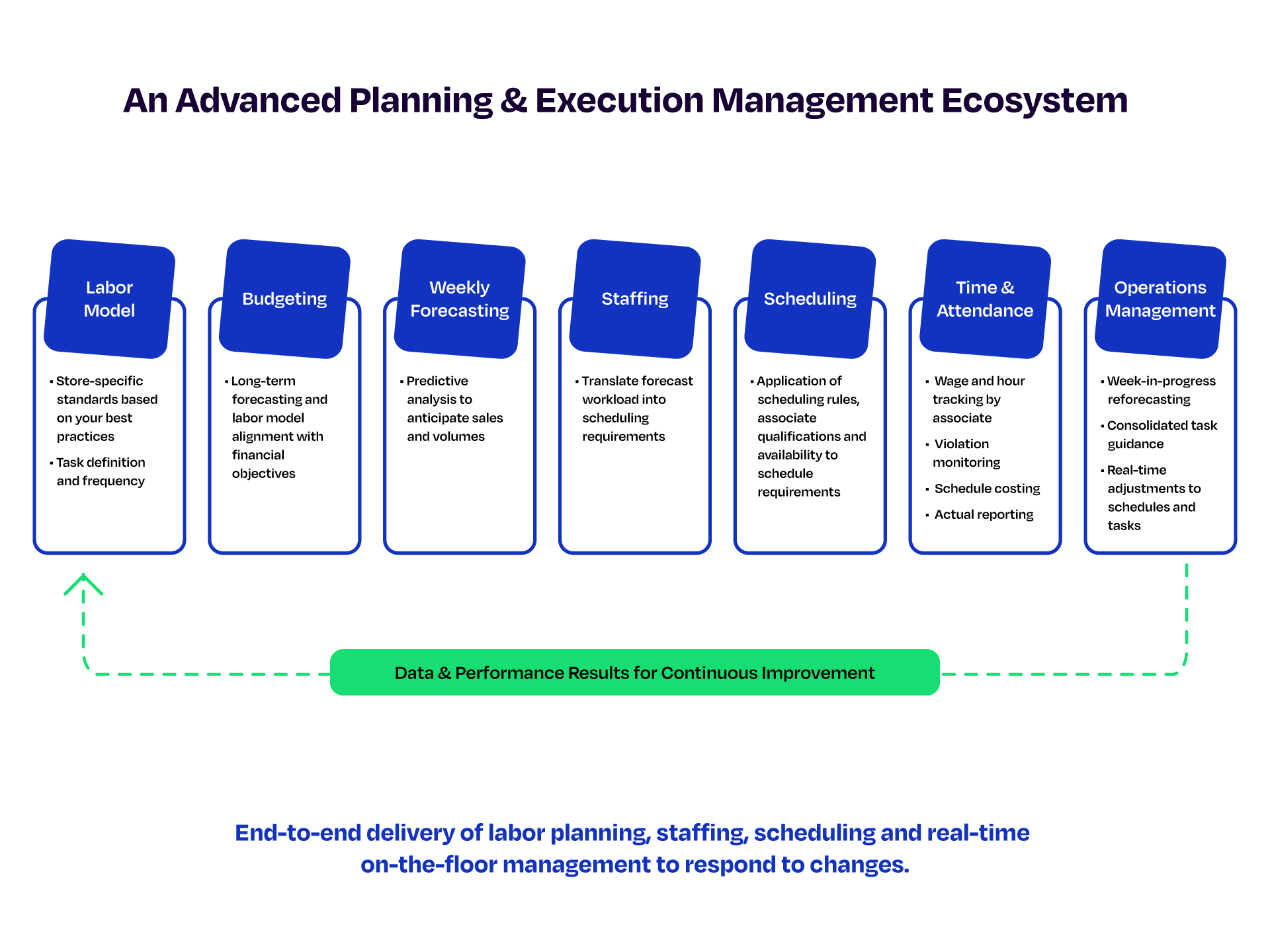
Our people
Logile is an end-to-end solution provider offering industrial engineering services, industry-leading software, deployment and training expertise, and retail experience in store execution and change management.
Our team consists of industrial engineers, data and integration experts, software professionals, and experienced retail practitioners. This enables Logile to be a complete solution provider with a full understanding of the challenges and opportunities our customer organizations face. We understand retail, and we understand planning and execution management.
Too many organizations have invested in labor standards only to find they are unable to implement those standards systematically in their planning (budgeting, period planning, weekly forecasting, and scheduling) to leverage the value. That is the difference between hiring an industrial engineering firm and hiring an end-to-end solution provider.
If you are looking for a strategic partner willing to help you craft a path for strategic planning and execution within your organization, look to Logile.
Top-down and bottom-up planning
Many organizations have managed labor goals using a top-down approach where executive leaders determine a labor goal. That goal gets allocated by store for each period and may or may not be detailed by department. Stores do their best to meet their piece of the overall goal, sometimes compromising store conditions, merchandising programs or service levels to meet the challenge.
In a bottom-up approach, work content from each store is based on the labor model. The corporate budget is the rollup of the individual stores. Typically, budgets are detailed by store, by week and by department with fixed and variable components delivering labor required to perform all work and to meet all service and merchandising standards.
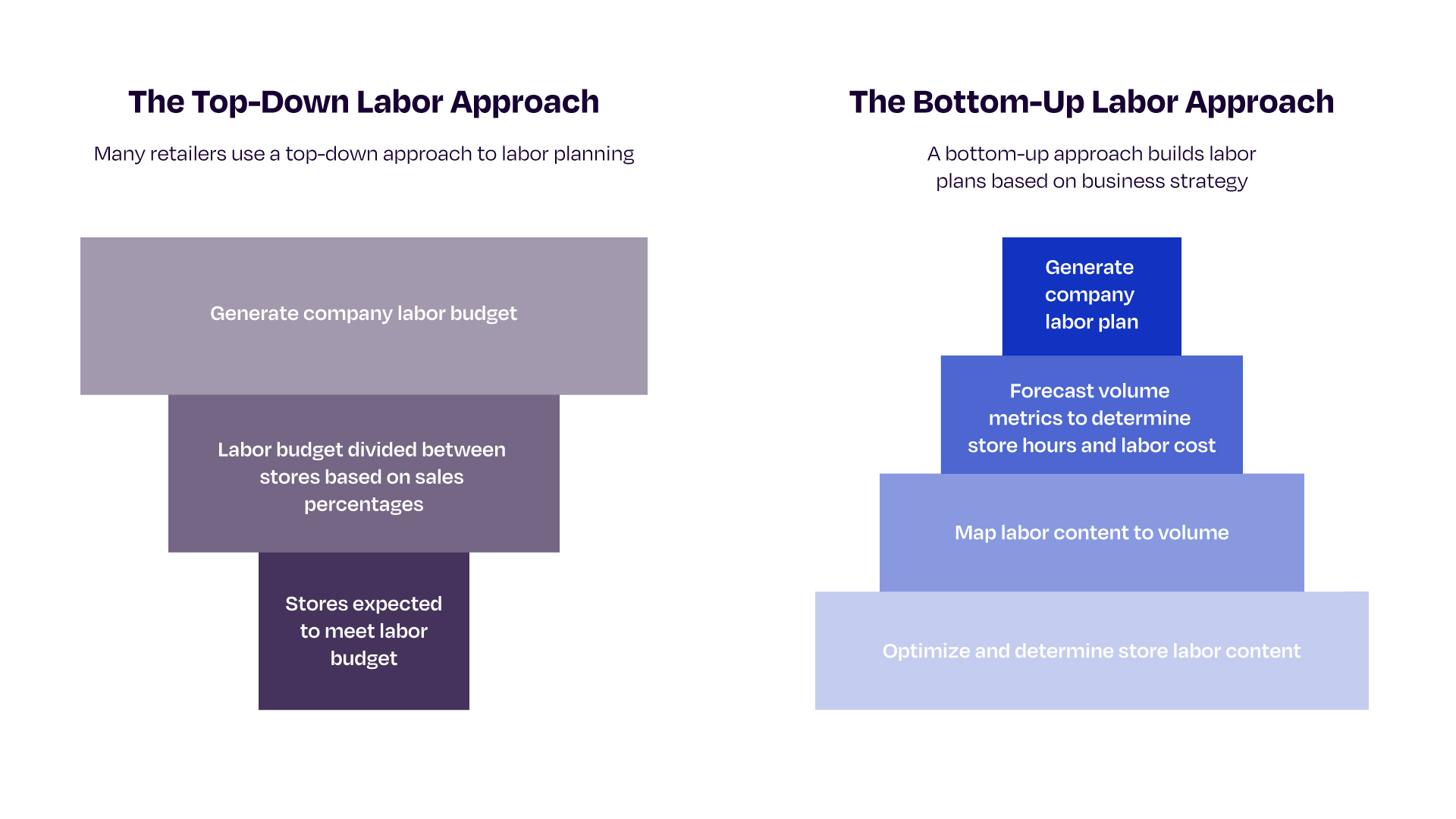
These approaches do not need to be mutually exclusive. The Logile approach is to leverage your labor model to facilitate a bottom-up plan. Once that is rolled up, the organization can recognize that the resulting labor content is required to support the brand in the way currently defined. The labor model is flexible to change to align the bottom-up approach to the top-down objectives.
It is healthy for organizations to revisit programs that have not produced expected results and to eliminate these programs and activities at the store level. Also, businesses typically review the frequency of certain activities and any productivity initiatives designed to remove labor at the store. Technology is a strong enabler of higher productivity. By updating the activities impacted by new technology, less labor is required.
Measuring and managing productivity
Productivity is observable and measurable. We analyze productivity in three dimensions.
- Utilization: Are employees working or not working?
- Methods: Are employees doing their work following the prescribed best method that supports safety, food safety and customer satisfaction?
- Performance: Are employees working with the skill, zeal and effort that is expected and reasonable?
We have techniques to quantify each dimension in a range from 0 percent to 100 percent effective. Once you understand current productivity performance, we can help you target improvements for measurable results.
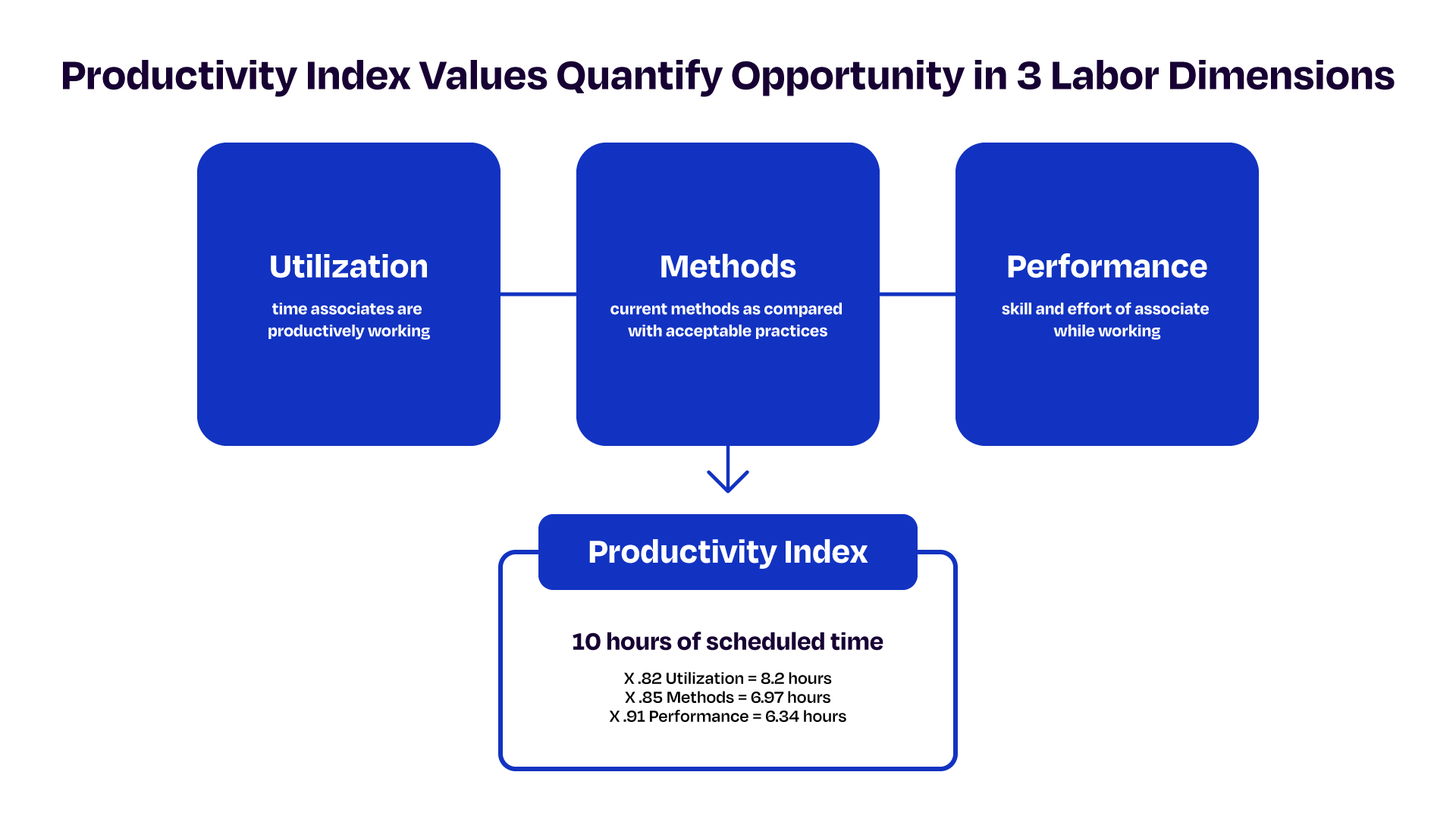
In the above example, a department is getting 6.34 hours of real work for every 10 hours scheduled—and that is before determining that associates are working on the right things!
Making real progress on productivity is a combination of managing numerous things:
- Creating the conditions for success in training and best-practice coaching.
- Workplace organization to save footsteps and fingerprints and engage associates in managing their shared work environment.
- Effective planning to put associates on the schedule when the work is required.
- Competent management guidance to ensure associates are working on the right things.
- Performance management and accountability.
- Continuous process improvement through the management of best methods and standards.
Three engineering apps to measure and monitor productivity and performance
What we measure, we can manage. Logile’s toolset of specialized apps includes three vital components to understanding your current business and identifying potential improvement initiatives: Utilization Studies, Queue Analysis and Customer Journey Analysis. With these tools, you can quantify current-state performance and identify performance opportunities.
These three apps come with our Enterprise Labor Model and facilitate your team’s ability to conduct fact-based measurement and identify many improvement opportunities:
- Utilization Studies: The best tool to measure the most basic component in enhancing productivity.
- Queue Analysis: See if your observations validate your customer service as employees work to your labor standards. Measure the actual service delivered to customers. What is the length of each queue? What is the average time in queue? How do service options like express enhance overall throughput in the queue? Measure what is really happening in your stores by day and by time of day.
- Customer Journey Sampling: Develop facts around the customer journey through the store. Is the customer’s path in keeping with expected traffic flow? Are displays working to stop the customer and make a sale? Are high-volume items well located both for convenience and for supporting strong customer conversion in each department?
We also teach and train the basics of standards analysis and validation. Focus on the most impactful activities as 20 percent of the activities or less will typically account for 80 percent or more of the time needed. Our Standards Analyzer provides this Pareto analysis in each department while our UPC Analyzer allows you to understand and aggregate all the labor routines impacted by that UPC. Great things can happen when your people get the right tools and training to make continuous improvement a reality.
Task execution
Beyond workforce management, Logile is your provider for store planning and execution management. Our Task Engine supports a variety of solution-based apps to enhance many key aspects of execution management, with more apps already in development.
We not only want to schedule the right people at the place at the right time, but we want to ensure that they are doing the right things in the right way—following company best-practice guidance.
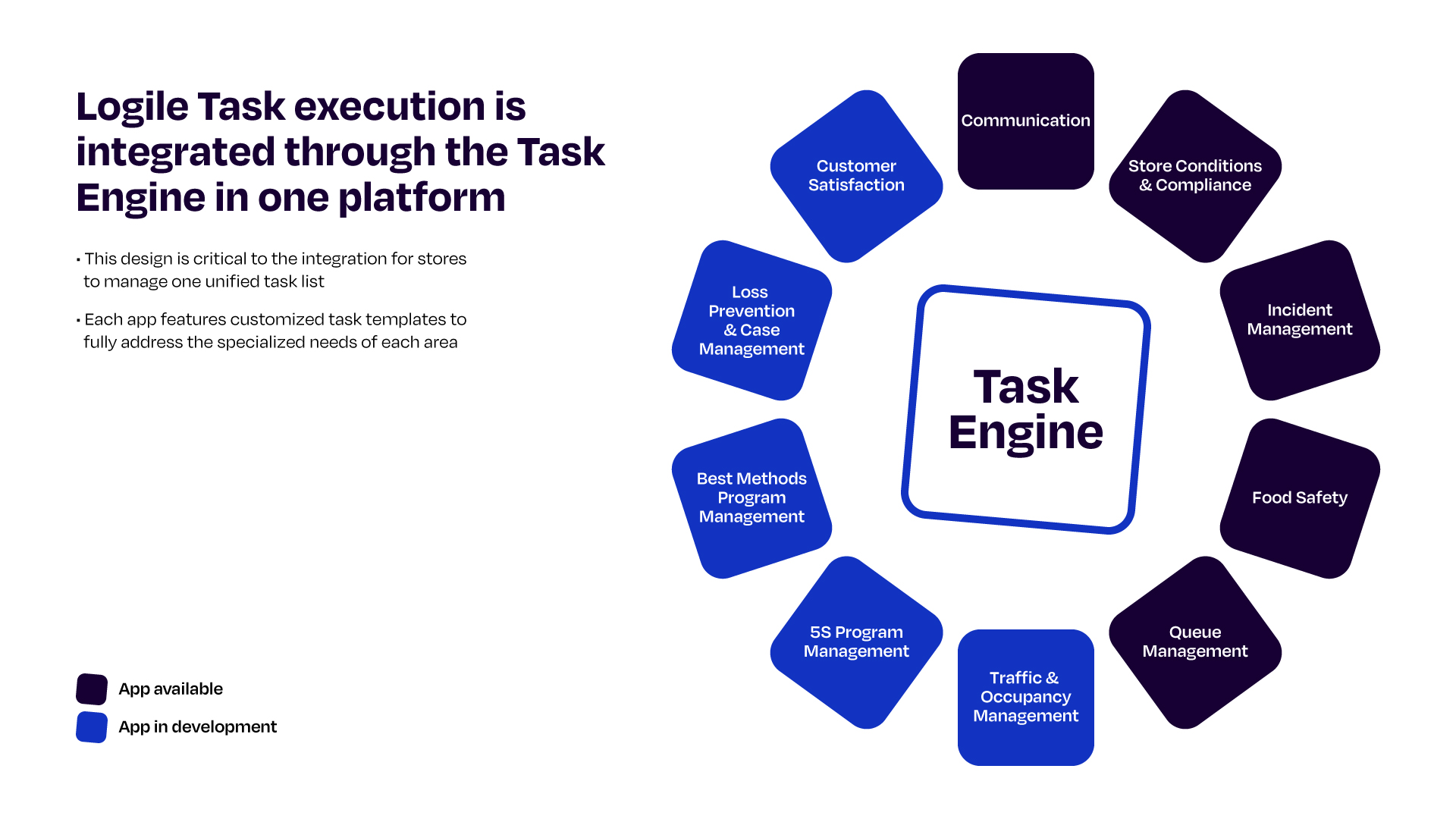
Our Task Engine and various apps are designed to help you deploy faster in each of these areas and to tailor our solutions to meet your brand-specific needs. Separate task and WFM solutions never achieve this level of integration. We offer a seamless solution on an integrated platform that makes deployment, training and store use much easier for stores to achieve best results.
Key to our objective is the creation of a unified work list—by department or by associate—that combines the Heartbeat tasks defined in the labor model with corporate directives, specialized tasks from our solution-based apps, and store-created task items. This makes for a highly customizable solution you can tailor to your business requirements to guide associates to do what is needed in the right way. Our execution management design is a total game changer.
